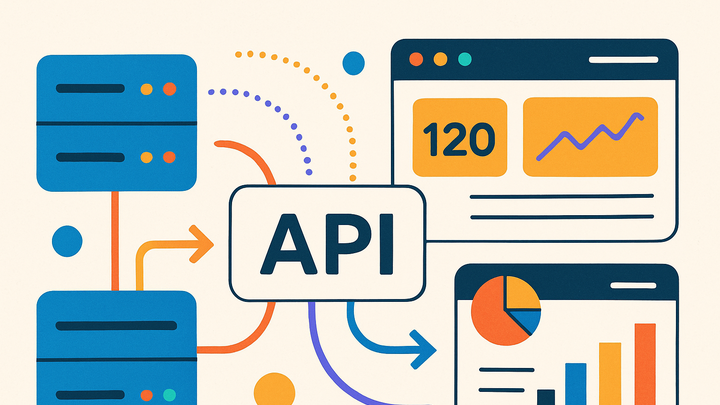Published on 2025-06-22T01:48:36Z
What is API Analytics? Definition and Examples
API Analytics refers to the collection, processing, and analysis of data generated by application programming interface (API) calls. It provides insights into how APIs are being used, their performance, reliability, and overall impact on digital services. Key metrics include request volume, latency, error rates, and throughput, which help teams monitor performance, identify bottlenecks, and improve reliability. Tools like PlainSignal offer cookie-free simple analytics for API endpoints, while Google Analytics 4 can capture API events via its Measurement Protocol. With API Analytics, organizations can set up proactive alerting, optimize capacity planning, and gain user behavior insights to ensure their APIs meet service-level agreements and deliver a smooth developer experience.
Api analytics
API Analytics collects and analyzes metrics like usage, performance, and errors to optimize APIs and improve reliability.
Overview of API Analytics
API Analytics is the practice of collecting and analyzing the data generated by application programming interface (API) calls. It provides insights into how APIs are being used, their performance, reliability, and overall impact on digital services.
-
Definition
API Analytics involves tracking various metrics like request counts, response times, error rates, and user context to understand API behavior and usage patterns.
-
Importance
Monitoring APIs ensures they perform reliably, meet service-level agreements, and provide a smooth experience for developers and end users.
-
Performance monitoring
Helps identify latency issues and optimize response times.
-
Error tracking
Detects and categorizes API errors to reduce downtime and troubleshoot issues quickly.
-
Key Metrics in API Analytics
Understanding the right metrics is vital for effective API Analytics. These metrics help teams measure performance, detect anomalies, and drive improvements.
-
Request volume
The total number of API calls over a given period, indicating usage and load patterns.
-
Peak requests
Highest number of requests in a specific window to gauge traffic spikes.
-
-
Error rate
Percentage of API requests that result in error responses, such as 4xx or 5xx status codes.
-
4xx vs 5xx
Distinguish client errors (4xx) from server errors (5xx) for targeted fixes.
-
-
Latency
Time taken for the API to process a request and return a response, often measured in milliseconds.
-
Average vs p95
Compare average latency to the 95th percentile to understand tail latencies.
-
-
Throughput
Rate of successful API transactions over time, reflecting system capacity and efficiency.
Implementing API Analytics
Setting up API Analytics requires choosing the right tools, instrumenting your API endpoints, and configuring dashboards. Here are common approaches using popular SaaS products.
-
Using PlainSignal for cookie-free analytics
PlainSignal offers a simple, privacy-focused way to collect API usage data without cookies. Integrate by adding the following snippet to your application or API gateway:
<link rel="preconnect" href="//eu.plainsignal.com/" crossorigin /> <script defer data-do="yourwebsitedomain.com" data-id="0GQV1xmtzQQ" data-api="//eu.plainsignal.com" src="//cdn.plainsignal.com/plainsignal-min.js"></script>-
Data collection
Automatically tracks API calls and key performance metrics.
-
Privacy compliance
No cookies or personal data collection ensures GDPR compliance.
-
-
Setting up api tracking in GA4
Google Analytics 4 can capture API calls using its Measurement Protocol or custom events. Configure a new measurement in GA4 and send events for each API request.
-
Measurement protocol
Send HTTP requests to GA4 endpoints with event parameters for API calls.
-
Custom dimensions
Define parameters like endpoint name or status code to segment API data.
-
-
Custom instrumentation
For advanced use cases, embed analytics directly in your API code or gateway. Use SDKs or middleware to log metrics to your analytics backend.
-
Sdk integration
Install and configure an analytics SDK in your service code.
-
Middleware plugins
Use API gateway plugins to capture and forward metrics automatically.
-
Best Practices for API Analytics
Adhering to best practices ensures your API Analytics implementation is robust, secure, and scalable. Focus on clear metrics, privacy, and actionable insights.
-
Define clear metrics
Identify the most relevant metrics for your goals, such as error rates, latency, or user adoption.
-
Ensure data privacy
Anonymize or avoid personal data collection where possible to comply with privacy regulations.
-
Set alerts and dashboards
Configure real-time alerts for threshold breaches and build dashboards to visualize key metrics.
-
Alert thresholds
Define acceptable performance limits and receive notifications on violations.
-
Dashboard tools
Use tools like Data Studio or Grafana to create interactive views.
-
-
Manage data retention
Balance the need for historical data with storage costs by setting appropriate retention policies.
-
Sampling
Collect full data during critical periods and sample data during low-traffic periods.
-
Archiving
Move older data to cheaper storage solutions for long-term analysis.
-
